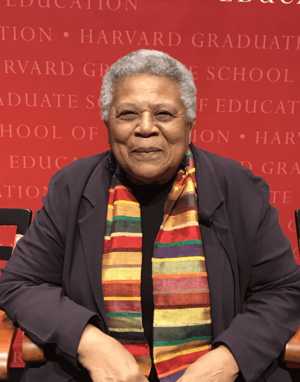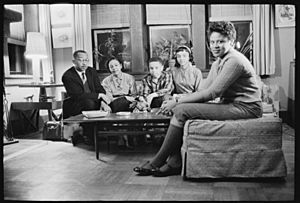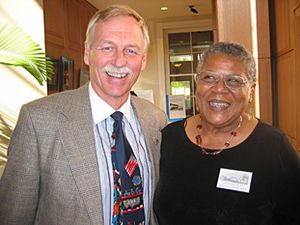Minnijean Brown-Trickey facts for kids
Quick facts for kids
Minnijean Brown-Trickey
|
|
|---|---|

Brown-Trickey speaking at the Harvard Graduate School of Education on February 9, 2018
|
|
| Deputy Assistant Secretary of the Department of the Interior For Workforce Diversity |
|
| In office 1999–2001 |
|
| President | Bill Clinton |
| Personal details | |
| Born | September 11, 1941 Rogers, Arkansas, U.S. |
| Residence | Canada |
| Alma mater | Laurentian University |
| Occupation | Civil rights activist |
| Awards include the Congressional Gold Medal and Spingarn Medal | |
Minnijean Brown-Trickey (born September 11, 1941) is an American civil rights activist. She is famous for being a member of the Little Rock Nine. This was a group of nine African American teenagers who were the first black students to attend Little Rock Central High School.
Their brave actions helped end racial segregation in American public schools. This followed a major court decision called Brown v. Board of Education.
Contents
Early Life and Education
Minnijean Brown was born in Little Rock, Arkansas, to Willie and Imogene Brown. She was the oldest of four children. Her father was a mason and landscaper, and her mother was a homemaker and nurse's aide.
She started high school in 1956 at Horace Mann, a school only for black students. In 1957, after the new laws against segregation, she chose to transfer to the all-white Little Rock Central High School. After being expelled from Central High, she moved to New York and finished her high school education at the New Lincoln School.
The Story of the Little Rock Nine
In September 1957, Minnijean Brown and eight other black students tried to start school at Little Rock Central High. A civil rights leader named Daisy Bates helped them organize. However, the governor of Arkansas, Orval Faubus, used the Arkansas National Guard to block them from entering.
This became a national issue. President Dwight D. Eisenhower sent U.S. soldiers to protect the students. On September 25, 1957, the Little Rock Nine finally walked into Central High School for the first time.
A Difficult School Year
Even with soldiers at the school, the Little Rock Nine faced constant bullying from some white students. They were called names and physically harassed.
Minnijean was the first of the Nine to be suspended. In December 1957, while being bothered by other students in the cafeteria, she accidentally dropped her tray and spilled chili on two boys. She was suspended for six days.
Later, in February, a group of girls threw a heavy purse at her. Minnijean reacted by calling them an insulting name and was immediately expelled from the school. After she left, some students passed around a note that said, "One down, eight to go."
After being expelled, Minnijean moved to New York. She lived with Drs. Kenneth and Mamie Clark, who were psychologists. Their work had been important in the Brown v. Board of Education court case. She finished high school at the New Lincoln School in Manhattan.
Life After Central High
Minnijean Brown-Trickey later attended Southern Illinois University to study journalism. In 1967, she married Roy Trickey, and they had six children.
In the 1980s and 1990s, she lived in Canada. She studied social work at Laurentian University and earned a master's degree from Carleton University.
From 1999 to 2001, she worked for President Bill Clinton's government. She was the Deputy Assistant Secretary for Workforce Diversity in the Department of the Interior. In this role, she helped make sure people of all backgrounds were treated fairly at work.
A Voice for Change
Brown-Trickey became a powerful public speaker. She has shared her story in almost every U.S. state and in other countries like Canada, England, and South Africa. She said one of her most meaningful moments was speaking at an award ceremony for Malala Yousafzai.
She has received many honors for her work. These include the Congressional Gold Medal, which she and the other members of the Little Rock Nine received in 1999. She also won the Spingarn Medal, a top award from the NAACP.
Portrayals in Movies
Minnijean Brown-Trickey's story has been told in movies made for television. She was played by actress Regina Taylor in the 1981 movie Crisis at Central High. In 1993, she was played by Monica Calhoun in the Disney Channel movie The Ernest Green Story.
A documentary film called Journey to Little Rock: The Untold Story of Minnijean Brown Trickey was also made about her life in 2002.



